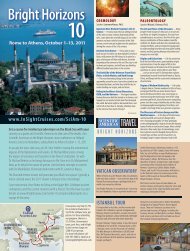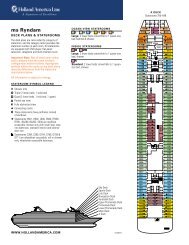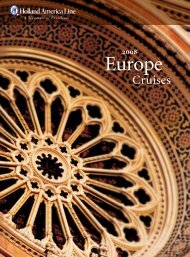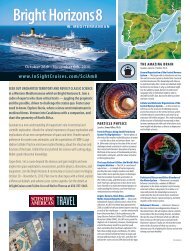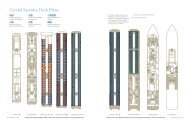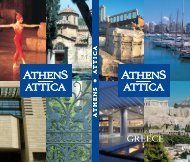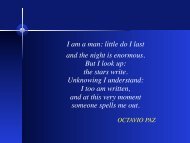Croatian cultural heritage - Business - Hrvatska turistiÄka zajednica
Croatian cultural heritage - Business - Hrvatska turistiÄka zajednica
Croatian cultural heritage - Business - Hrvatska turistiÄka zajednica
You also want an ePaper? Increase the reach of your titles
YUMPU automatically turns print PDFs into web optimized ePapers that Google loves.
Today it is a memorial area, which is prevailed by "The Jasenovac Flower" (2) monument.<br />
Posavina is known today for villages with family houses of traditional folk<br />
construction, and the famous arks (12 & 13) with characteristic wooden structures<br />
and ornaments (8). Among these villages, the most famous is Čigoć, located<br />
in the Lonja Field (Lonjsko Polje). In 1994, the village was proclaimed the first<br />
European village of storks (9).<br />
Due to the abundance of thermal waters and traditions of their use, central Croatia<br />
has the most spas in the country. Some of them were founded in Roman times,<br />
and the best evidence of this is the Varaždin spa, the former Aquae Isae (6). The<br />
importance of central <strong>Croatian</strong> spas is shown through monumental bathing buildings,<br />
especially in Daruvar (4) and Lipik (5).<br />
The spirit of central Croatia comes to the fore in late Renaissance and Baroque<br />
towns such as Varaždin, Bjelovar, Sisak, Koprivnica, Samobor and Čakovec. They<br />
preserved the typical central European building <strong>heritage</strong>, mostly from the 16th<br />
and 17th centuries. They have especially beautiful main city squares, such as the<br />
one in Koprivnica, decorated with a landscaped park (16), the Samobor square,<br />
which boasts an old fountain (17), or the main square in the city for pilgrims of the<br />
Holy Blood of Jesus in Ludbreg, where it is symbolically marked as the "centre of<br />
the world" -- "Centrum mundi" (24).<br />
Many buildings, such as the 17th century palace Prassinsky-Sermage in Varaždin<br />
attract with their beautiful design (29). Particularly interesting are the bridges,<br />
such as the Old Bridge made from red brick in Sisak (15), and the pursuit of beautiful<br />
horticulture is evident in city parks and cemeteries. Among them is the most<br />
beautiful cemetery in Varaždin. Decorated with high hedges, it also serves as a<br />
park (18).<br />
Numerous findings from the past and works of art are stored in museums that<br />
exist in almost every city. Most of them are regional types with several different<br />
collections, such as the Samobor Museum (30), but there are also specialised museums,<br />
such as the Food Museum in Koprivnica (22). Central Croatia has a strong<br />
artistic tradition and there are also many galleries, such as the Gallery Stančić in<br />
Varaždin, dedicated to its famous painter (25).<br />
The town of Varaždin has a special place among cities in central Croatia because<br />
of its preserved and valuable <strong>heritage</strong> and museums. It especially comes into play<br />
during Špancirfest, a typical Central European Festival of street strollers (19).<br />
Špancirfest is held at the end of August every year and is known to gather close to<br />
200 000 visitors and more than one thousand artists from twenty different countries.<br />
The trademarks of Špancirfest are the traditional uniforms of the past (20) and<br />
costumed events (21 & 26). Here we can see renewed old crafts (28) and the significant<br />
musical culture (27) of Varaždin. Various traditional products can be purchased<br />
on the spot and gastronomic specialties can be tasted. Špancirfest is also a<br />
good place to purchase paintings (23).<br />
The most beautiful ornaments of central Croatia are considered to be its CASTLES<br />
and FORTRESSES, which cannot be found in such numbers and forms anywhere<br />
else in Croatia. Among them, the first place is occupied by Trakošćan castle (37),<br />
located amidst thick forests above a romantic lake in the northwestern corner of<br />
Croatia. It was built as a small fortress in the 13th century, and received its latest<br />
form in the late 19th century, at the time of the Drašković counts.<br />
The luxury of Trakošćan is especially visible in its towers (39) and the entrance to<br />
the castle (38), and the attention to detail can be seen in the auxiliary buildings<br />
and yards (40). The museum located in its chambers houses the most valuable<br />
collection of old weapons and military equipment in Croatia (36). It was largely<br />
furnished personally by Count Drašković, and apart from the many old rifles (35)<br />
we can also find old medieval armour (31). The museum also exhibits valuable old<br />
furniture (32 ) and lots of old books and writings (34).<br />
The old town of Varaždin from the 16th century also stands out with its magnificence<br />
(48) and with a central town museum. To the North of Varaždin, in the<br />
31<br />
32<br />
33<br />
34<br />
35<br />
48<br />
36






